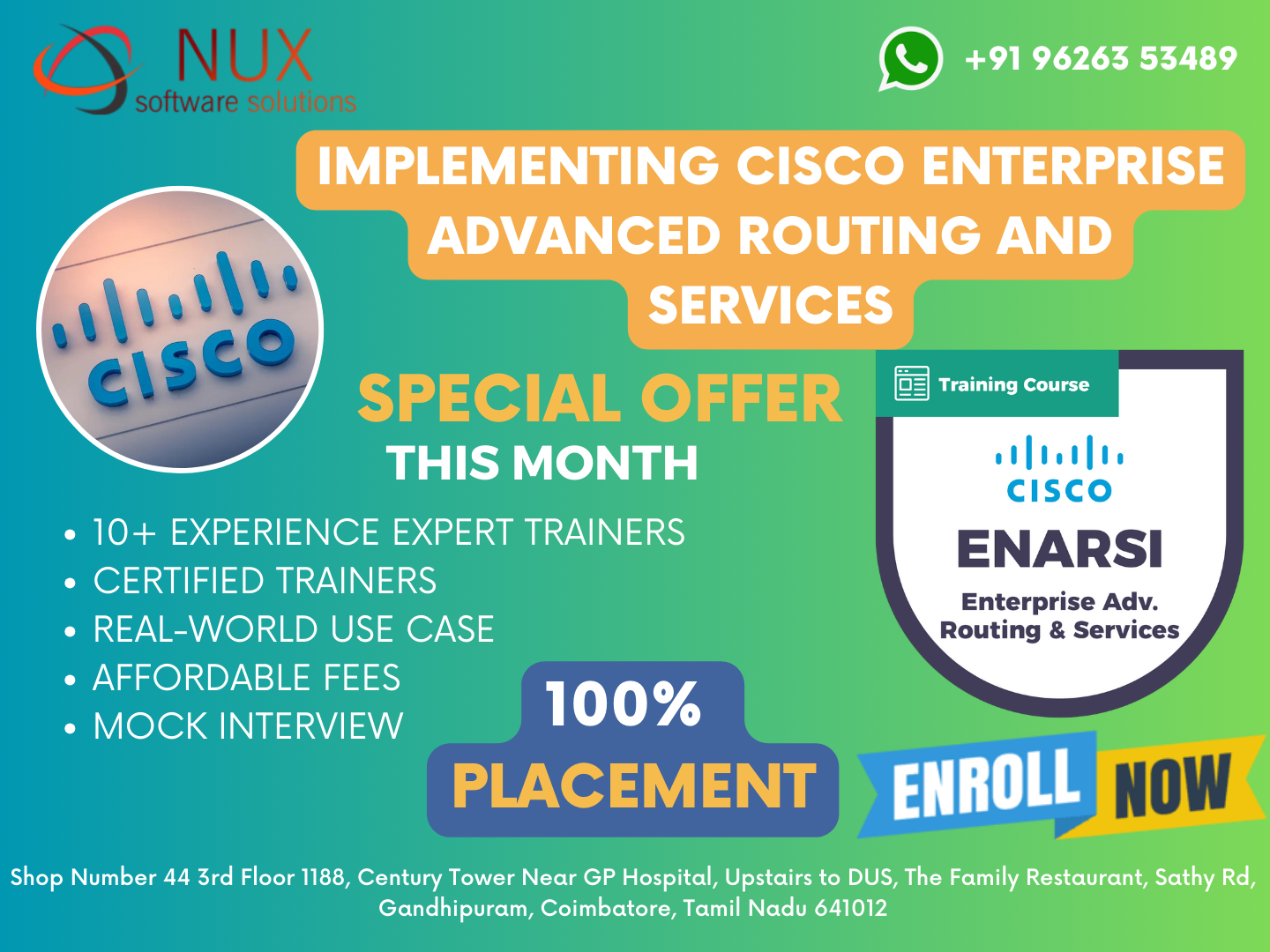Cisco 200-901 DevNet Associate (DEVASC)


Cisco 200-901 DevNet Associate (DEVASC) is indeed a robust cloud solution, and NuxSoftwareIT Training & Certification Solutions is your go-to destination to become an expert in this field. We have consistently positioned ourselves as a premium institute, delivering top-notch training across various IT domains. Our team comprises experts and highly qualified faculties dedicated to providing quality training to our students. With a focus on Cisco 200-901 DevNet Associate, we ensure that our learners gain comprehensive knowledge and hands-on experience to excel in this dynamic and in-demand field.
The Cisco 200-901 DevNet Associate (DEVASC)
At NuxSoftware Training & Certification Solutions, we take pride in our highly customized and effective course material designed for Cisco 200-901 DevNet Associate (DEVASC). Our approach is centered around hands-on application and extensive lab work to provide our students with maximum practical exposure. This emphasis on practical learning ensures that our learners not only grasp theoretical concepts but also acquire the skills needed to achieve their goals in the professional IT field.
Course Syllabus
Cisco 200-901 DevNet Associate (DEVASC) Syllabus
1. Compare data formats (XML, JSON, and YAML)
2. Describe parsing of common data format (XML, JSON, and YAML) to Python data structures
3. Describe the concepts of test-driven development
4. Compare software development methods (agile, lean, and waterfall)
5. Explain the benefits of organizing code into methods / functions, classes, and modules
6. Identify the advantages of common design patterns (MVC and Observer)
7. Explain the advantages of version control
8. Utilize common version control operations with Git
Clone
Add/remove
Commit
Push / pull
Branch
Merge and handling conflicts
diff
1. Construct a REST API request to accomplish a task given API documentation
2. Describe common usage patterns related to webhooks
3. Identify the constraints when consuming APIs
4. Explain common HTTP response codes associated with REST APIs
5. Troubleshoot a problem given the HTTP response code, request and API documentation
6. Identify the parts of an HTTP response (response code, headers, body)
7. Utilize common API authentication mechanisms: basic, custom token, and API keys
8. Compare common API styles (REST, RPC, synchronous, and asynchronous)
9. Construct a Python script that calls a REST API using the requests library
1. Construct a Python script that uses a Cisco SDK given SDK documentation
2. Describe the capabilities of Cisco network management platforms and APIs (Meraki, Cisco DNA Center, ACI, Cisco SD-WAN, and NSO)
3. Describe the capabilities of Cisco compute management platforms and APIs (UCS Manager, UCS Director, and Intersight)
4. Describe the capabilities of Cisco collaboration platforms and APIs (Webex Teams, Webex devices, Cisco Unified Communication Manager including AXL and UDS interfaces, and Finesse)
5. Describe the capabilities of Cisco security platforms and APIs (Firepower, Umbrella, AMP, ISE, and ThreatGrid)
6. Describe the device level APIs and dynamic interfaces for IOS XE and NX-OS
7. Identify the appropriate DevNet resource for a given scenario (Sandbox, Code Exchange, support, forums, Learning Labs, and API documentation)
8. Apply concepts of model driven programmability (YANG, RESTCONF, and NETCONF) in a Cisco environment
9. Construct code to perform a specific operation based on a set of requirements and given API reference documentation such as these:
Obtain a list of network devices by using Meraki, Cisco DNA Center, ACI, Cisco SD-WAN, or NSO
Manage spaces, participants, and messages in Webex Teams
Obtain a list of clients / hosts seen on a network using Meraki or Cisco DNA Center
1. Describe benefits of edge computing
2. Identify attributes of different application deployment models (private cloud, public cloud, hybrid cloud, and edge)
3. Identify the attributes of these application deployment types
Virtual machines
Bare metal
Containers
4. Describe components for a CI/CD pipeline in application deployments
5. Construct a Python unit test
6. Interpret contents of a Dockerfile
7. Utilize Docker images in local developer environment
8. Identify application security issues related to secret protection, encryption (storage and transport), and data handling
9. Explain how firewall, DNS, load balancers, and reverse proxy in application deployment
10. Describe top OWASP threats (such as XSS, SQL injections, and CSRF)
11. Utilize Bash commands (file management, directory navigation, and environmental variables)
12. Identify the principles of DevOps practices
1. Describe the value of model driven programmability for infrastructure automation
2. Compare controller-level to device-level management
3. Describe the use and roles of network simulation and test tools (such as VIRL and pyATS)
4. Describe the components and benefits of CI/CD pipeline in infrastructure automation
5. Describe principles of infrastructure as code
6. Describe the capabilities of automation tools such as Ansible, Puppet, Chef, and Cisco NSO
7. Identify the workflow being automated by a Python script that uses Cisco APIs including ACI, Meraki, Cisco DNA Center, or RESTCONF
8. Identify the workflow being automated by an Ansible playbook (management packages, user management related to services, basic service configuration, and start/stop)
9. Identify the workflow being automated by a bash script (such as file management, app install, user management, directory navigation)
10. Interpret the results of a RESTCONF or NETCONF query
11. Interpret basic YANG models
12. Interpret a unified diff
13. Describe the principles and benefits of a code review process
14. Interpret sequence diagram that includes API calls
1. Describe the purpose and usage of MAC addresses and VLANs
2. Describe the purpose and usage of IP addresses, routes, subnet mask / prefix, and gateways
3. Describe the function of common networking components (such as switches, routers, firewalls, and load balancers)
4. Interpret a basic network topology diagram with elements such as switches, routers, firewalls, load balancers, and port values
5. Describe the function of management, data, and control planes in a network device
6. Describe the functionality of these IP Services: DHCP, DNS, NAT, SNMP, NTP
7. Recognize common protocol port values (such as, SSH, Telnet, HTTP, HTTPS, and NETCONF)
8. Identify cause of application connectivity issues (NAT problem, Transport Port blocked, proxy, and VPN)
9. Explain the impacts of network constraints on applications


